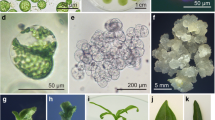Summary
Regeneration of plants from protoplasts of potato (Solanum tuberosum) cv. ‘Maris Bard’ has been achieved from four different initial culture media (ET2, ET3, CLG, VkCLG). These media differed in their hormone, salt and sugar content. Plating efficiencies were highest in the VkCLG medium, but no correlation was found between plating efficiency and regeneration frequency (i.e. the percentage of calli producing shoots). Regeneration frequencies were high on all four media; up to 95% on ET3. Chromosome counts of up to 50 regenerants selected at random from the four treatments showed no significant differences between any of the treatments, in the proportions of plants which were euploid (48), aneuploid at the tetraploid level (48±), and aneuploid with high chromosome numbers (48+ +). Highly significant differences were present, however, between shoots which rooted quickly (predominantly euploid) and those which rooted only after transfer to a rooting medium (predominantly 48+ +). Overall more than 60% of the regenerants were normal (2n=4x=48) and this is a considerable improvement on our earlier work in this cultivar (4% normal). These findings are discussed in relation to factors affecting chromosome stability. Chromosome structural rearrangements are also described.
Similar content being viewed by others
References
Baker RJ, Nelder JA (1978) The GLIM system. Release 3. Oxford Numerical Algorithms Group
Banks-Izen MS, Polito VS (1980) Changes in ploidy level in calluses derived from two growth phases of Hedera helix L. the English Ivy. Plant Sci Lett 18:161–167
Barbier M, Dulieu H (1983) Early occurrence of genetic variants in protoplast cultures. Plant Sci Lett 29:201–206
Bayliss MW (1975) The effects of growth in vitro on the chromosome complement of Daucus carota (L) suspension cultures. Chromosoma 51:401–411
Browers MA, Orton TJ (1982) Transmission of gross chromosomal variability from suspension cultures into regenerated celery plants. J Hered 32:159–162
Carlberg I, Glimelius K, Eriksson T (1984) Nuclear DNA-content during the initiation of callus formation from isolated protoplasts of Solanum tuberosum L. Plant Sci Lett 35:225–230
Creissen GP, Karp A (1985) Karyotypic changes in potato plants regenerated from protoplasts. Plant Cell Tissue Organ Culture 4:171–182
Evans DA, Gamborg OL (1982) Chromosome stability of cell suspension cultures of Nicotiana spp. Plant Cell Rep 1:104–107
Foulger D, Jones MGK (1986) Improved efficiency of genotype-dependent regeneration of important potato cultivars. Plant Cell Rep 5:72–76
Ghosh A, Gadgil VN (1979) Shift in ploidy level of callus tissue: A function of growth substances. Indian J Exp Biol 17:562–564
Gunn RE, Shepard JF (1981) Regeneration of plants from mesophyll-derived protoplasts of British potato (Solanum tuberosum L.) cultivars. Plant Sci Lett 22:97–101
Horak J, Lustinec J, Mesieck J, Kaminek M, Polackova D (1975) Regeneration of diploid and polyploid plants from the stem with expiants of diploid narrow stem kale (Brassica oleracea L.). Ann Bot 3:571–577
Jacobsen E, Tempelaar MJ, Bijmolt EW (1983) Ploidy levels in leaf callus and regenerated plants of Solanum tuberosum determined by cytophotometric measurements of protoplasts. Theor Appl Genet 65:113–118
Karp A, Nelson RS, Thomas E, Bríght SWJ (1982) Chromosome variation in protoplast-derived potato plants. Theor Appl Genet 63:265–272
Karp A, Bright SWJ (1985) On the causes and origins of somaclonal variation. In: Miflin BJ (ed) Oxford surveys of plant molecular and cell biology, vol 2. Cambridge, pp 199–234
Kasperbauer MJ, Collins GB (1972) Reconstitution of diploids from leaf tissue of anther-derived haploids in tobacco. Crop Sci 12:98–101
Larkin PJ, Scowcroft WR (1981) Somaclonal variation — a novel source of variability from cell cultures for plant improvement. Theor Appl Genet 60:197–214
Matern U, Strobel G, Shepard JF (1978) Reaction to phytotoxins in a potato population derived from mesophyll protoplasts. Proc Natl Acad Sci USA 75:4935–4939
Murashige T, Nakano R (1967) Chromosome complement as a determinant of the morphogenic potential of tobacco cells. Am J Bot 54:963–970
Murashige T, Skoog F (1962) A revised medium for rapid growth and bioassays with tobacco tissue cultures. Physiol Plant 15:473–497
National Institute of Agricultural Botany (1975) Guide to the identification of potato varieties. Cambridge, UK
Ogihara Y (1981) Tissue culture in Haworthia. 4. Genetic characterisation of plants regenerated from callus. Theor Appl Genet 60:353–363
Orton TJ (1980) Chromosome variability in tissue cultures and regenerated plants of Hordeum. Theor Appl Genet 56:101–102
Secor GA, Shepard JF (1981) Variability of protoplast-derived potato clones. Crop Sci 21:102–105
Shepard JF, Bidney D, Shahin E (1980) Potato protoplasts in crop improvement. Science 208:17–24
Singh BD, Harvey BL (1975) Effects of different 2,4-D concentrations on the cytogenetic behaviour of plant cells cultured in vitro. Biol Plant 17:167–174
Sree Ramulu K, Dijkhuis P, Roest S (1983) Phenotypic variation and ploidy level of plants regenerated from protoplasts of tetraploid potato (Solanum tuberosum L. cv ‘Bintje’). Theor Appl Genet 65:329–338
Sree Ramulu K, Dijkhuis P, Roest S, Bokelmann GS, DeGroot B (1984) Early occurence of genetic instability in protoplast cultures of potato. Plant Sci Lett 36:79–86
Sree Ramulu K, Dijkhuis P, Hanisch Ten Cate Ch.H., De Groot B (1985) Patterns of DNA and chromosome variation during in vitro growth in various genotypes of potato. Plant Sci Lett 41:69–78
Thomas E (1981) Plant regeneration from shoot culture-derived protoplasts of tetraploid potato (Solanum tuberosum) cv ‘Maris Bard’. Plant Sci Lett 23:84–88
Thomas E, Bright SWJ, Franklin J, Lancaster V, Miflin BJ, Gibson R (1982) Variation amongst protoplast-derived potato plants (Solanum tuberosum cv ‘Maris Bard’). Theor Appl Genet 62:65–68
Vanzulli L, Magnien E, Olivi L (1980) Caryological stability of Datura innoxia calli analysed by cytophotometry for 22 hormonal combinations. Plant Sci Lett 17:181–182
Wenzel G, Schieder O, Prezewozny T, Sopory SK, Melchers G (1979) Comparison of single cell culture derived (Solanum tuberosum L.) plants and a model for their application in breeding programs. Theor Appl Genet 55:49–55
Author information
Authors and Affiliations
Additional information
Communicated by R. Riley
Rights and permissions
About this article
Cite this article
Fish, N., Karp, A. Improvements in regeneration from protoplasts of potato and studies on chromosome stability. Theoret. Appl. Genetics 72, 405–412 (1986). https://doi.org/10.1007/BF00288580
Accepted:
Issue Date:
DOI: https://doi.org/10.1007/BF00288580




